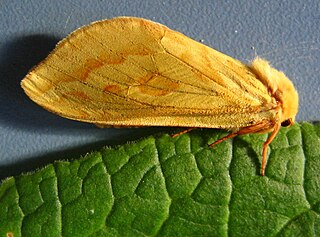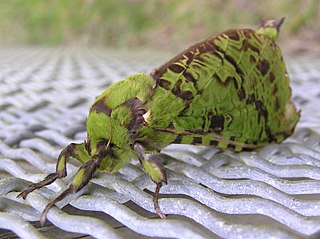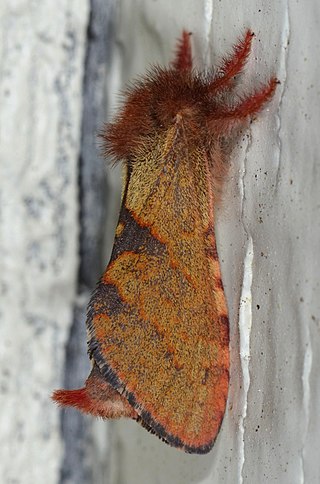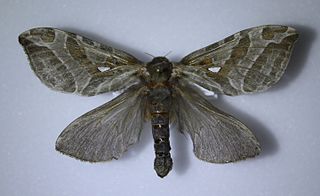
The Hepialidae are a family of insects in the lepidopteran order. Moths of this family are often referred to as swift moths or ghost moths.

The ghost moth or ghost swift is a moth of the family Hepialidae. It is common throughout Europe, except for the far south-east.

Aenetus is a genus of moths of the family Hepialidae. There are 24 described species found in Indonesia, New Guinea, New Caledonia, Australia and New Zealand. Most species have green or blue forewings and reddish hindwings, but some are predominantly brown or white. The larvae feed in the trunks of living trees, burrowing horizontally into the trunk, then vertically down.

Phymatopus is a genus of moths of the family Hepialidae, which consists of around 700 species and 82 genera. The genus was erected by Hans Daniel Johan Wallengren in 1869. They can be found across Eurasia and North America. Species can be distinguished by the different morphology of male genitalia and different forewing patterns, which vary in stripe colour and size and arrangement of spots. The stripes themselves consist of spots separated by dark veins which are fringed by thin black lines from both inner and outer sides.

Sthenopis is a genus of moths of the family Hepialidae. There are eight described species found in North America and China.
Endoclita buettneria is a species of moth of the family Hepialidae. It is known from Myanmar. The food plant for this species is Byttneria.

Endoclita damor is a species of moth of the family Hepialidae. It is known from India and the Himalayas. Food plants for this species include Albizia, Altingia, Cinchona, Coffea, Erythrina, Eugenia, Glochidion, Manglietia, Nyssa, Schima, Tectona, Tetradium, and Theobroma.
Endoclita excrescens is a species of moth of the family Hepialidae. It is known from Japan and the Russian Far East. Food plants for this species include Castanea, Nicotiana, Paulownia, Quercus, and Raphanus. The species is considered a pest of the tobacco plant.

Endoclita malabaricus is a species of moth of the family Hepialidae. It is known from India.

Endoclita sinensis is a species of moth of the family Hepialidae. It is known from China, Korea and Taiwan, as well as from the Far East of Russia. Food plants for this species include Castanea and Quercus.
Endoclita undulifer is a species of moth of the family Hepialidae. It is known from India. Food plants for this species include Alnus, Byttneria, Callicarpa, Cryptomeria, Eucalyptus, and Gmelina.
Phassus pharus is a moth of the family Hepialidae first described by Herbert Druce in 1887. It is known from Guatemala. Food plants for this species include Malvaceae and grasses such as sugar cane.

Phymatopus hectoides is a species of moth belonging to the family Hepialidae. It was described by Jean Baptiste Boisduval in 1868, and is known from the western United States, including California, Arizona, Nevada and Oregon.

Sthenopis argenteomaculatus, the silver-spotted ghost moth, is a species of moth of the family Hepialidae. It was described by Thaddeus William Harris in 1841, and is known in North America from Nova Scotia to North Carolina and west to Minnesota.

Sthenopis pretiosus, the gold-spotted ghost moth, is a species of moth of the family Hepialidae. It was first described by Gottlieb August Wilhelm Herrich-Schäffer in 1856. It can be found in found Brazil, Venezuela and in the eastern United States and south-eastern Canada.
Sthenopis dirschi is a species of moth of the family Hepialidae. It was described by Otto Bang-Haas in 1939, and is known from China.

Sthenopis purpurascens, the four-spotted ghost moth, is a species of moth of the family Hepialidae. It was described by Packard in 1863. It is found in Canada and the United States, from Labrador and New York north and west to British Columbia and the Northwest Territories, south in the mountains to Arizona.
Sthenopis regius is a species of moth of the family Hepialidae. It was described by Staudinger in 1896, and is known from China.
Sthenopis roseus is a species of moth of the family Hepialidae. It was described by Oberthür in 1912, and is known from China, including Hubei.
S. purpurascens may refer to:












